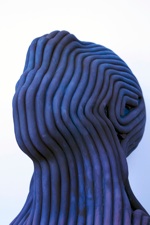Drôleries
- Dominic PAPILLON
Dominic Papillon’s sculptural work emerges from the intimate junctions of heterogenous, tactile elements. Structured and unstructured, abstract and figurative, monstruous and delightful, the exuberance or sobriety of line, crudely fashioned or made with refined simplicity – these all are coupled together to give form to materials, and with the artists hand transmit enigmatic figures at once attractive and disturbing. In other words, from this unholy alliance of opposing forces and the bastardization of figures a sense of unexpected grace surges forth from his work, beyond all conventions and norms, highlighting the fact that beauty is oftentimes found in unlikely places. Primarily, Papillon fabricates and gives life to this sculptural universe so as to seduce the senses and the affect of the viewers. His willingness to “create imagery with ambiguous semantic contours from a substance that is at once sensual and strange”1 is rooted in a body of works oriented towards producing effects rather than establishing precise significations ready for decoding.
The Drôleries project certainly fits within and extends the artist’s research methodology. On the one hand we recognize Papillon’s marked interest in traditional forms of sculpture, while on the other we see his fascination with the grotesque in art. Most all of his works should be seen ‘in the round’ and recall (subtly but surely) ancient statuary practices and how they represent sculpted bodies extending into space and that benefit from being examined from all angles. Most every piece is placed on a base, which for a long time was the only acceptable way to present sculpture, but which is currently banished from modern and contemporary sculpture. Furthermore, Papillon’s techniques and preferred materials (molding, casting, assemblage, plaster, porcelain) are connected to an ancestral knowledge of the medium. However, rather than leaning towards the classical canon – that for centuries constructed the profile of western sculpture – he instead turns towards grotesque iconography for inspiration in his elaboration of figures: a source more vast and open to all kinds of expressions. Moreover, the title of the exhibition echoes aspects of medieval illuminated manuscripts with their decorative marginalia and where we see wacky fantastical creatures, sporting bizarre combinations of unrelated features – perhaps half human, half animal or half plant-like.
With baroque, rococo and surreal aspects, Papillon’s drôleries present themselves as a varied collection of curiosities. An anonymous, dark mauve bust stretches itself mysteriously towards the rear; a monstrous unformed creature reminds us, by its elongated posture, of an Egyptian sphinx; round spheres with heavy textures appear as faceless heads; a pair of upside down legs open their inner thighs to the gaze…
Take note that despite his loose way of interpreting forms, Papillon’s sculptures remain profoundly related to the body. No doubt this is because the organic framework of the body links us irrefutably to the world; all sensations are awakened and begin with the body. To conclude, one could say that the primary material of this artist is the body – with its particular zones of intensity, the effect of its presence and its capacity for metamorphosis.
Ariane de Blois, author, art historian
1 Quotation from an unpublished text by Dominic Papillon about his practice.
Born in Montréal, Dominic Papillon lives and works in his native city. He holds a Bachelors Degree in Visual Arts (UQAM, 2006) and a Masters in Sculpture (Concordia, 2009). His work engages mostly with sculpture and installation. His first solo exhibition, Cheap Thrills, was held at the Maison de la culture de Notre-Dame-de-Grâce in Montreal in 2009. His work has been shown in many group exhibitions including Collision V at the Parisian Laundry (Montréal, 2009) and Nostalgie du présent at Circa (Montreal, 2010). Dominic Papillon is a recipient of several grants, including the Jacques de Tonnancour award for excellence (UQAM), the Dale and Nick Tedeschi Studio Arts Fellowship (Concordia) and a research and creation grant from the Conseil des arts et des lettres du Québec. Drôleries is the fifth solo exhibition of the artist and the first one in Montreal since 2009.
Ariane de Blois is an art historian who teaches at Collège de Rosemont in Montreal. She will soon hold a PHD in Art History from McGill University resulting from a thesis about half-human, half-animal grotesque sculpture in contemporary art. She curated the exhibition Et si les robots mangeaient des pommes ? presented at the Maison des arts de Laval in 2013-2014 and co-curated the exhibitions Rejouer/Déjouer le folklore : Suisse–Québec, presented at the Maison de la culture Frontenac (Montreal, 2012) and at the Stadtgalerie de Berne (Switzerland, 2012); Instantes : Adad Hannah, presented at the Centro Nacional de las Artes in Mexico (Mexico, 2012); La Mécanique de l’objet, presented, inter alia, at Centre Raymond-Lasnier de Trois-Rivières (2011-12) and Faire semblant/Fake it!, presented at Studio XX (Montreal, 2010). Her texts were published notably in the art magazines Esse, Etc. and in the Musée d’art de Joliette catalog, where she is part of the CA.








